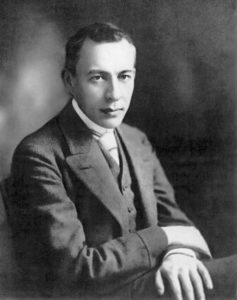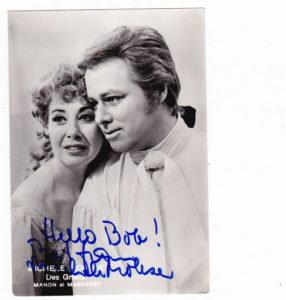
We mark the first complete performance of Sergei Rachmaninoff’s Piano Concerto No. 2 on November 9, 1901 – 119 years ago today – in Moscow. Rachmaninoff (1873-1943) was the piano soloist. The performance was conducted by his cousin: the pianist, conductor and composer Alexander Siloti (1863-1945).
Before moving on to Rachmaninoff’s second piano concerto and the compelling story behind it, we’ve an utterly irresistible anniversary to note.

It was on this day in 1974 – 46 years ago today – that the unthinkable occurred onstage at the New York City Opera, and no, I’m not talking about copulating dogs during the Act I party scene of Rigoletto. The opera being performed was Giuseppe Verdi’s Un ballo in Maschera (“The Masked Ball”) of 1859. In the starring role of Riccardo was the Italian-American tenor Michele Molese. Molese was a mainstay of the New York City Opera, and over the years he appeared there in almost every leading tenor role in the standard repertoire. He was known, particularly, as being among Beverly Sills’ favorite leading men, and together they appeared in new productions of, among other operas, Manon (by Jules Massenet, 1884), Faust (Charles Gounod, 1859), and Lucia di Lammermoor (Gaetano Donizetti, 1835).
On November 1, 1974, the chief music critic for The New York Times, Harold Schonberg, attended a performance of Un Ballo. Schonberg’s subsequent review mentioned Molese’s “pinched high C”, referring to what he considered the strained quality of Molese’s climactic “C” an octave above middle “C”. No one likes to be criticized, least not tenors, and least not their high “Cs” which are, truly, the pride of their musical manhood. (Criticize a tenor’s ancestry; his mother, his sister’s virginity, whatever; BUT DO NOT MESS WITH HIS HIGH C! Capice?) So it was that eight days later, during a repeat performance of Un Ballo on November 9, after having nailed that high “C” like Simeone Biles landing after a vault, Michele Molese turned to the cheering audience, stepped out of character, and announced that:
“The last high “C” has been dedicated to Harold C. Schonberg.”
OMG: do we have even an inkling of how many singers and musicians have wanted to say and do something just like that? Molese brought the house down. Unfortunately, the next day, the house fell on Molese and he was summarily fired for “unprofessional conduct”. The company’s general manager, Julius Rudel, informed the press that he did not anticipate Molese would ever sing for the New York City Opera again.
Liar, liar, pants on fire. Molese was simply too popular and too indispensable to the company to be gone for long, so return he did, many times. His final performance with the City Opera took place 6 years later, in 1980, when he played Mario Cavaradossi in Tosca (by Puccini, 1900).
Rachmaninoff, Piano Concerto No. 2
The premiere performance of Rachmaninoff’s Second Piano Concerto on this day in 1901 saw the 28-year-old Rachmaninoff’s career as a composer reborn, a career that Rachmaninoff himself believed had come to an inglorious end four years earlier, in 1897.
Here’s what happened.… Continue reading only on Patreon
Become a Patron!Listen on the Music History Monday
Podcast: Play in new window
Subscribe: Apple Podcasts | Spotify | Pandora | iHeartRadio | RSS | More
